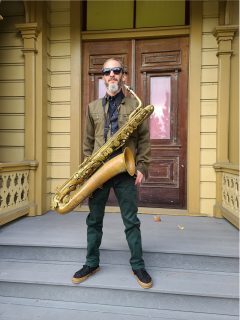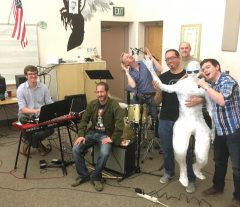Featured Stories
The Nontraditional Tradition of Gabriel Sundy
Gabriel Sundy was in a quandary. The musician and composer was racking his brains trying to figure out what kind of music it was on a recent recording. “What kind of music is this? I don’t even know!” he was heard to say.
With all the distortion and loudness, was it metal? Was it head-banging punk? Odd motifs and odd time signatures bounced in and out of the tunes, like tracks from an old Gentle Giant LP. So was it progressive rock? Free jazz?
Sundy could not put his finger on it. What kind of music was it?
One thing for certain, the music was Gabriel Sundy’s.
Sundy was listening back to the tracks of his recently released recording Human Like an Animal, which he released December 19th. He says, “I asked Rafter Roberts, who coproduced the recording, how he would categorize this music and he said, ‘progressive punk jazz noise rock.’”
Progressive. Punk. Jazz. Rock.
And maybe even kitchen sink.
Welcome to the musical world of Gabriel Sundy. The San Diego native has, for years, made a reputation for himself of being a musical gadfly, making music that defies genres and categories. He has delighted—and challenged—audiences with his Applebrown Jazz Ensemble or his workings with the Industrial Jazz Group, both of which test the limits of harmony and melody. Or there is his work with Nexus 4000, which has drawn influence from the ethereal and muscular progressive rock music that the Mahavishnu Orchestra produced some 45 years ago.
Human Like an Animal continues this nontraditional tradition of Sundy’s to make music that can leave even himself flummoxed. As he explains, Human Like an Animal is a melding of attitudes, with the overarching attitude being punk, of taking things to extremes. And yet the recording is progressive in that it draws on different genres and incorporates a lot of different time signatures. “I think there are two songs on the disk that are in 4/4,” Sundy says. Everything else finds itself in 5/4, 7/8, 9/8, or some other time signature or any combination thereof. “I’ve always had this compulsion to make music that other people weren’t making. For this disk, things are all over the place. It took several months to notate what I heard in my head.
“I want to challenge the listener. I want them to question some of their preconceived notions of what music is, what music can be.” Indeed, for me, often when I’ve listened to a recording of Sundy’s or heard one of his ensembles perform at one of our local venues, I’ve noticed how he may start with a riff that sounds like it fits exactly into a Motown recording from 1968, with the next thing I know that riff winds up twisting into a grunge or metal or even a jazz riff or line. Riffs and lines seem that they are inspired by punk or metal but they are not handcuffed to that genre.
To compose the pieces for the new CD, Sundy relied on a technique that he has used throughout his career. “I will pick up the flute, guitar, or sax, and I’ll record what I play. I’ll just play freestyle. And I’ll play it back and listen. Some of it might be quite good, but not what I’m looking for at the moment. I’m wanting to find something that resonates with me,” he says. Once Sundy finds a riff, theme, or motif that he wants to work with, he uses that as a starting point for a composition. He will, sometimes, compose on the guitar, but most of the ideas for this recent recording were worked out using the saxophone or the piano.
“I do what the music is telling me to do,” he says. “I allow myself to let the music create itself. A lot of what I do is try to intuit what is going to happen next, just let myself be open to what comes next and try not to force it, not have a preconceived idea beforehand as to how it’s all going to come out.” He says that he sometimes composes having a fuller idea of where the music will start and how it all ends, but in doing so he increases his chances of getting stuck musically.
To bring the music to fruition Sundy put together a power trio, something that he says has been an intended project for the last 15 years and which he calls Invisible Sky People. Originally, Invisible Sky Person number one was to be Gabe Serbian of Head Wound City, who has also worked with The Locust, Holy Molar, and Cattle Decapitation. But due to other obligations, nothing materialized back when Sundy approached Serbian back in 2007. In addition to Sundy, Invisible Sky Person number two on the album is Mackenzie Leighton, who provided the bass work.
The trio is noteworthy for its lack of piano or guitar. Others bandleaders have paired down an ensemble, removing these chordal instruments. Music without an instrument playing chords frees up the musicians. Even one of the most basic characteristics of western music, whether music is major or minor, can be less defined in such ensembles. “That’s what I wanted, 100 percent intentional openness,” Sundy says. “I wanted to make as much noise and create what I wanted. I wanted to expand my sound.”
For much of the recording Sundy used guitar effects pedals, the devices that give a guitar distortion, echo, reverb, and all the electronic magic upon which rock guitarists rely, and played his saxophone through them. Much of Leighton’s bass work is similarly processed.
Sundy is a lifelong musician, attempting to learn the saxophone when he was a second grader, but quit only after a couple months. When he was 12, he fell under the sway of the electric guitar and metal. The more Slayer, Anthrax, and Testament that he could play, all the better.
When he was 15, he drifted back to the saxophone and attended music events at Soma, back when it was downtown on Union Street. He has said, “Many of the bands that played down there had horns. It was different stuff for me and it got me even more excited about music in a different way.” He began serious study of the saxophone, taking private music lessons. Fortunately, he also discovered the vinyl collection of his mother’s boyfriend, which included Dizzy Gillespie, Gerry Mulligan, and other jazz greats. He entered Mesa College as a music major, transferring to San Diego State and graduating with a degree in jazz studies. He later earned a master’s degree in music from SDSU.
The genesis of Human Like an Animal goes back a ways. For quite some time Sundy had planned a relocation to the home of beignets and jazz, New Orleans. To finance the move, he worked on cruise ships. As it happened, Sundy wound up back in San Diego the second or third week of March, right when the lockdowns and restrictions kicked in due to the coronavirus pandemic. Moving plans were put on hold. With no move and gigs dried up because of Covid-19, Sundy had the time to work on this project that had been brewing for so long.
Whether New Orleans or San Diego winds up being Sundy’s home, he’ll continue to make music that goes beyond classifications and definitions. “I’ve often felt that language was limiting when it comes to communicating,” he says. “That’s why I’ve taken a lot of stock in music for communication. There is a lot of emotion there that can’t be put into words.”









